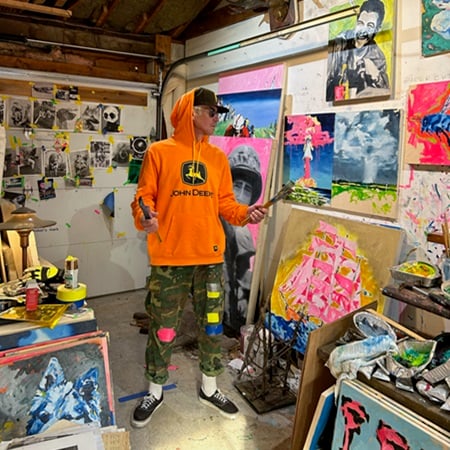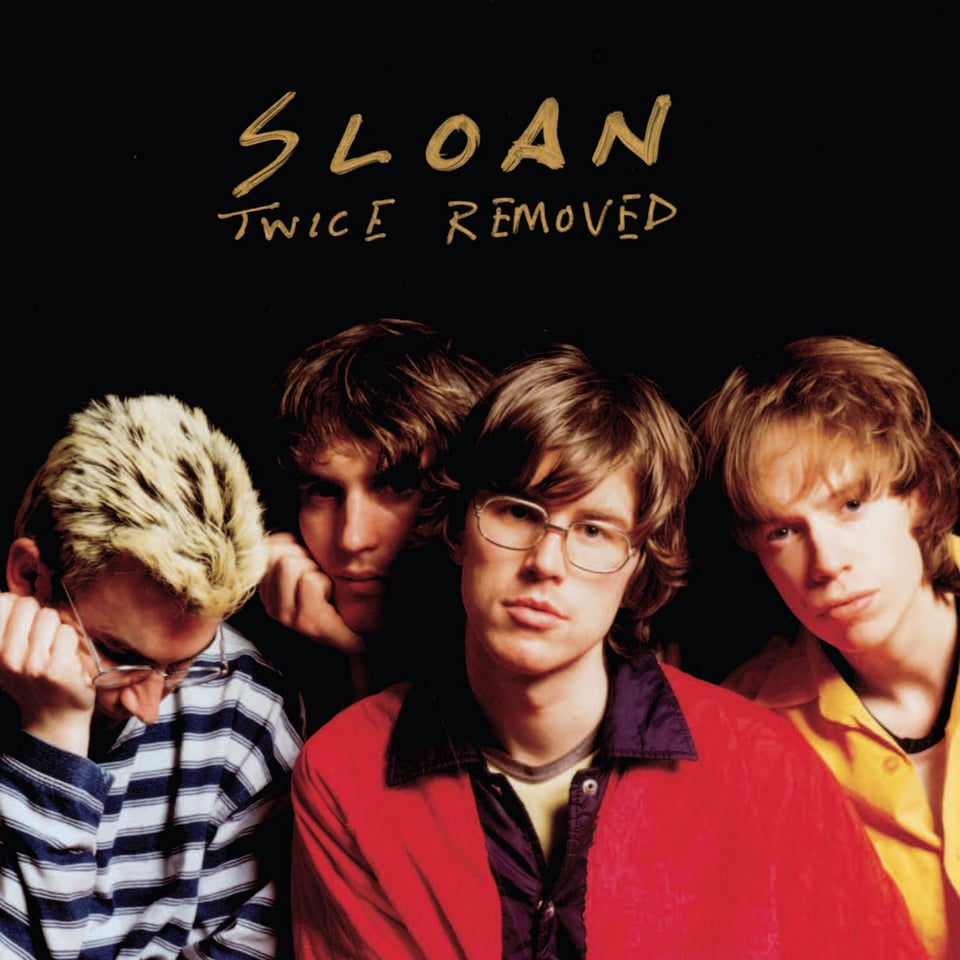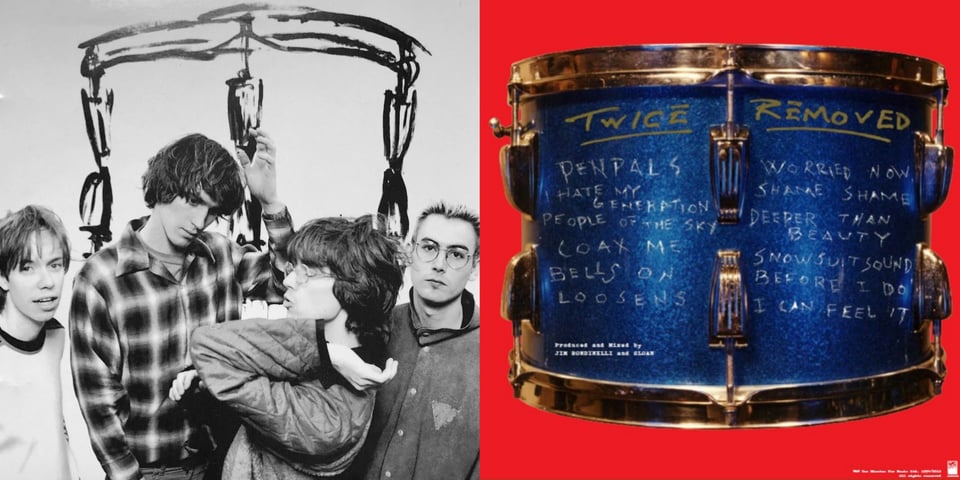Scratched toms and dumb-fun collage: Sloan's Andrew Scott talks Twice Removed album art at 30

BY GREGORY ADAMS
Andrew Scott is putting in the work. When Gut Feeling reaches out to the Toronto-based musician and painter, he’s in a Saskatoon hotel room, a few hours out from taking the stage with Sloan, the beloved and prolific Canadian rock group he co-founded back in 1991.
The band — drummer-guitarist Andrew, bassist-drummer Chris Murphy, and guitarists Patrick Pentland and Jay Ferguson — have been hitting a number of fly-in appearances this summer. They’ve also been celebrating their harmonic history through a recent deluxe vinyl box set behind shoegazing 1992 debut album Smeared. Behind the scenes, Sloan are also racking up recordings for their fourteenth full-length, which will follow-up their especially strong Steady album from 2022.
Andrew is also a visual artist often throwing paint in his Toronto studio. Even when he’s not, the colours are still swirling in his head.
“I’ve always admired Chuck Close, a New York artist who just recently died,” he explains. “His thing was always, ‘Inspiration is for amateurs; the rest of us just show up and get to work.’ Those are words that I’ve lived by. And when I say I’m just showing up and getting to work, it could be I’m going to go out to the studio to make a cup of coffee. I don’t necessarily have to mix any paint around; I don’t have to clean any brushes or physically apply any paint. I just sit there and look around…but maybe that afternoon I’ll put some paint down.”
Though Andrew didn’t bring his oils out for this quick trip to the Prairies, his artistic passions have often crossed paths on the road. After leaving the Nova Scotia College of Art and Design (NSCAD) in the early ‘90s to travel with Sloan, he refined his collage skills while coasting on the tour bus.
At other points in their career, he started producing “weird, gestural” drumstick paintings out of Sloan’s gear trailer, applying a roller, black enamel Tremclad primer, and a dozen or so of his usual percussive tools to some thick cardstock.
“It sounds awful as it comes out of the mouth…but they’re actually really fucking cool,” he says, “If you look at them horizontally it’s almost like a snapshot of a landscape out of your car as you’re speeding by...very undefined. All day, every day I’ve got nothing to do but wait [before a set], so I was just generating a number of these paintings. They dry in about two seconds. I would sell them at gigs.”
Though Sloan are arguably in Smeared mode at the moment, this Friday (August 30th) likewise marks the 30th anniversary of the band’s fantastic sophomore follow-up, Twice Removed.
The record marked a major change for the group, generally taming the noise-dialing approach of their earliest songs towards a deeper, if sometimes distortion-weary melodicism. The record is also the lone Sloan LP where Andrew took the reins with the art direction, its layout an inspired mix of collage, evocative line work, and arguably the beginnings of his drum-driven artistic approach. Not everyone in the band loved the eclectic, mixed-media aesthetic, though. And that includes Andrew.
With all that in mind, Gut Feeling asked Andrew to get into the highs and lows of the band’s Twice Removed layout.
This interview has been edited and condensed for flow and clarity.

What do you remember about developing the overall visual aesthetic of Twice Removed?
ANDREW SCOTT: Well, it was kind of a testy time in our existence, just in terms of everybody jockeying for control of A, B, C and D, depending on what the circumstance was. I was the one who just came out of art school, though — I had literally dropped out, three credits short of a BA, to tour the world with this collection of people I barely knew. So, I liked the idea of taking the reins, visually, at some point.
But on Twice Removed, we were also dealing with the monster that was Geffen, and all that bullshit. People that had to pretend that they needed to chime in with their two cents, to make it sound like they were doing their jobs. There was an art department with an art director [Frank Olinsky]. But I didn’t meet him and go, “Ooh, I feel like I’m really good hands with this guy.” I just felt like I was dealing with a talking head from within the company. But I was young, cocky, stupid and arrogant. I thought I had all the fuckin’ answers, but looking back, I didn’t know shit from Shinola. None of us did back then.
When I started doing mock ups for [the layout], Chris and Jay would accuse [me of copying] Pavement’s artwork. I was like, “Dude, Pavement didn’t come up with any of that shit. They’re just using collage work that’s been made since 100 fucking years ago.” I was drawing from Dada, just weird 1915 collage shit.
Part of the story behind Twice Removed is that you had moved to Toronto as the rest of the band were working on the songs in Halifax. What was guiding your hand more when you first landed in Toronto: visual art or the band?
SCOTT: Neither. I moved to Toronto be with my then girlfriend, who’s now my wife and the mother of our two kids. So, I think I made the right choice, there.
What was the first piece of artwork you produced for Twice Removed?
SCOTT: Just shortly after Smeared came out, we made a split single with us, Eric’s Trip, Jale, and a band from Moncton called Idée du Nord. It was called Never Mind the Molluscs, and it was a Sub Pop thing. Getting involved with Sub Pop early on was pretty fun, a lot more of a laid-back dialogue with those people than it would have been with Geffen. I did the artwork for that.
Again, it was very collage-based. Easy to put together. Easy to photograph. I thought it turned out great, and I think everybody liked it. That would have been the catalyst, in my mind, for letting me do the artwork for [Twice Removed].
As you’re putting together the rest of the layout for the album, were you consciously trying to steer yourself away from collage work, since the rest of the band thought it was biting Pavement’s style? Or were you leaning into it more because of that complaint?
SCOTT: A little of both. But at the time when I was doing Twice Removed, I was not painting [regularly]. I didn’t even have a studio. I left school in ’91 to tour the world with this band. I took a gamble, rolled some dice, and I’m really glad I did! It wasn’t until ‘97 or ‘98 where I finally had a space in Toronto — back when it was affordable. I was like, “I’m just going to pick up where I left off and see what happens.” And when that happened, I never looked back.
But the collage stuff…if you’re dealing with a [creative] block, or you’re like, “Fuck…I’m not doing any work…I don’t have any good ideas,” just make weird little collages! It’s a dumb, fun way to kickstart your brain in a different way. I still do that, to this day.
Whenever we’d be on a lengthy tour, the entire front lounge of the bus would be completely covered in collage. To some people it might’ve been too much noise, or whatever. But for me, it transformed this dentist’s office waiting room on wheels into a place where you could actually sit and immerse yourself in a sea of imagery. I loved it.

One of the more striking images in this layout is of the full band standing in front of this large, rough-painted outline of a drum. Where was that produced?
SCOTT: That was produced in a guy named Michael Halsband’s loft studio in New York City, while we were recording Twice Removed. He did all of the photography for the record. He was a great guy, and his studio was so awesome. I can’t remember what the intersection was, but it was right in the thick of New York.
He’d be like, “Whatever you need, let’s just go across the street to the store and we’ll rent and buy whatever [supplies] we want.” I was like, “Ok, get me a projector, and I’ll mock up this drum!” Because [the actual] drum was also the back cover of Twice Removed — that blue sparkle tom with all the song titles and credits etched into it. I was just trying to tie that in with some kind of liner note/gatefold/pull-out-poster kind of thing.
Then there was other stuff involved, like these weird stock racing cars that had nothing to do with anything. But I didn’t care! Murph in my band, he’s so hung up on everything needing to refer to something else, specifically, but I was just like, “Dude, that’s not how I see or think about shit.”
Was the actual drum ever on your kit?
SCOTT: Yup! It was like an early ‘60s Ludwig 14-inch rack tom. That was not my actual version of it [on the back cover], though. That was from Lenny Kravitz’s studio in Hoboken, where we recorded a third of Twice Removed. He had this crazy gear room full of all this vintage equipment.
So that’s Lenny Kravitz’ drum?
SCOTT: That’s his drum, but I do have that same kit.
Did Lenny Kravitz ever come up to you like, “Why did you carve these song titles into my drum?”
SCOTT: Well, they weren’t carved directly into the tom. They were carved into a photograph of the tom, and then we photographed that. But I wish I had carved them in!
There’s a line drawing in the layout of a drummer who I’m presuming is you — they’re wearing a suit and sitting behind a kit with a Sloan logo on it. Did you draw or trace that off a still from your “Coax Me” video?
SCOTT: No, that’s not me. It’s an old jazz cat named Jack Parnell. My dad was a jazz drummer, and he had all these old music notation books. When he passed away in ’82, I hung onto all of that shit just out of sentimentality. So, I had this image of Jack Parnell sittin’ behind the kit. I think he was holding both of his cymbals, as if to choke them, and I thought it was a cool image. I traced it out and we made a t-shirt out of it.
The Twice Removed art also has a panel of this pair of Great Dane-lookin’ dogs in it, while you’re currently posting a bunch of dog paintings you’ve done more recently to your Instagram. Where did that interest come from?
SCOTT: It just came from my obsession with dogs. If anybody knows me as a quote-unquote painter today, I would venture to guess that they would refer to these blue dogs that I’ve been painting all these years. And you know, I tripped over [the theme] at school one day, and ended up refining and cranking out all these dog paintings. Monochrome blue dog. Head-and-shoulders, portrait-style on a square canvas. I wouldn’t paint the backgrounds; I would just leave the raw canvas to play against the intensity of this particular blue that I would use, which was called Phthalo Blue.
To me and to everybody who saw them, they really worked. There was something there. Then it was like, “Well…how much longer do you think you can wring this cloth out?” What do you know, I’m still wringin’ it today.

Do you have any stories behind these dogs you’re painting? I’m looking at your “Jumper” right now, literally a dog jumping through a hoop. Was that something you saw in-person?
SCOTT. No. A lot of people commission me to paint their pets, or their cars and trucks There are definitely stories to the pets I’m generating a likeness of, but I don’t know necessarily know what they are. I operate from pictures.
With “Jumper,” the one you referenced, that was just an image in a book…I don’t know who that dog is. [laughs] I just saw how dynamic it was and thought, “Yeah, let’s fuckin’ paint that!”
Have you ever tried working with a live model, though? Another one I’m looking at, “Jeff,” has got these super-soulful eyes staring back at us. You ever bring a dog into the studio to be your muse?
SCOTT: I’m not going to lie, I’ve never tried that. I’ve got two cats, and I’ve never bothered to try and get them to sit there. For one, my studio is kind of a gross and dirty collection of dust. The dogs don’t want to be there, as much as I don’t want them to be in there. I prefer to work from pictures…it gives me the option of taking my sweet time.

Let’s get back to Twice Removed. Having produced the artwork, layout and design of the album — and likewise having steered the ship against some resistance — how do you look back on the overall presentation of this, from a visual standpoint?
SCOTT: I’d give it a 4/10. My least favourite cover out of all of our albums.
Why’s that?
SCOTT: I just hate the picture of us, such a po-faced bunch of down-and-out goofs. I think we look fucking stupid.
What does work for you?
SCOTT: Never Hear the End of It, that’s a great album cover. One Chord to Another? Great. Between the Bridges? That’s another 4/10. Pretty Together is a great album cover, too.
A cohesive visual aesthetic tightens up as Sloan moves along — most of those covers leaning into that that high-contrast, duotone band portrait presentation.
SCOTT: That wasn’t random.
What appeals to you about that look?
SCOTT: I like it because it’s graphic and stark. It cuts out all the bullshit.
Jay Ferguson is arguably the brand police within our group, and he draws pretty obviously from early ‘60s albums where all the members of the band are on the cover. He wants our body of work to resemble something like the Stones, the Who, or the Beatles. And I dig that, too.
We’re taking about this Twice Removed anniversary, and the band are also in Smeared mode because of the new box set…but are you working any new Sloan songs?
SCOTT: Yeah, we basically have an album-and-a-half just sitting there waiting to be refined. We did a bunch of recording this past winter.
Do you have any paintings you’re working on at the moment?
SCOTT: I have two very recent commissions that I’ve yet to even begin. I’ve got some work to do, but I’m also trying to squeeze out as much of a typical Canadian summer as I can, too. A lot of times I just want to sit around with my kids and my wife. So, summer’s not high painting season for me, necessarily.
That said, everything can change on a dime for me. All I have to do is just go into the studio and start moving paint around. If something’s working, then I can keep coming back to it. If it’s not, I can put it aside and go, “Fuck it…I’m going to go read a book.”
Further reading: You can find out more about the Ripped Jeans and RAT Pedals on Sloan’s rawest early recordings through Gut Feeling’s 2020 interview with guitarist Jay Ferguson.
You can also find out more about the racecar-shaped wah pedals and harmonic experiments of Sloan’s Steady LP in my 2022 interview with guitarist Patrick Pentland, which is up at Guitar World.